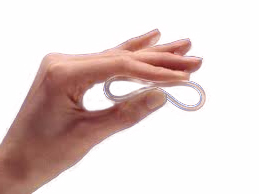Vaginal Ring
The vaginal ring is a small, soft plastic ring containing oestrogen and progestogen that you insert into your vagina for 21 days. It's about 4mm thick, and 5.5cm in diameter.

You place the ring in your vagina on the first day of your period, remove it 21 days later and throw it in the bin (not down the toilet) in a special disposal bag. Seven days after removing the ring, you insert a new one for the next 21 days.
